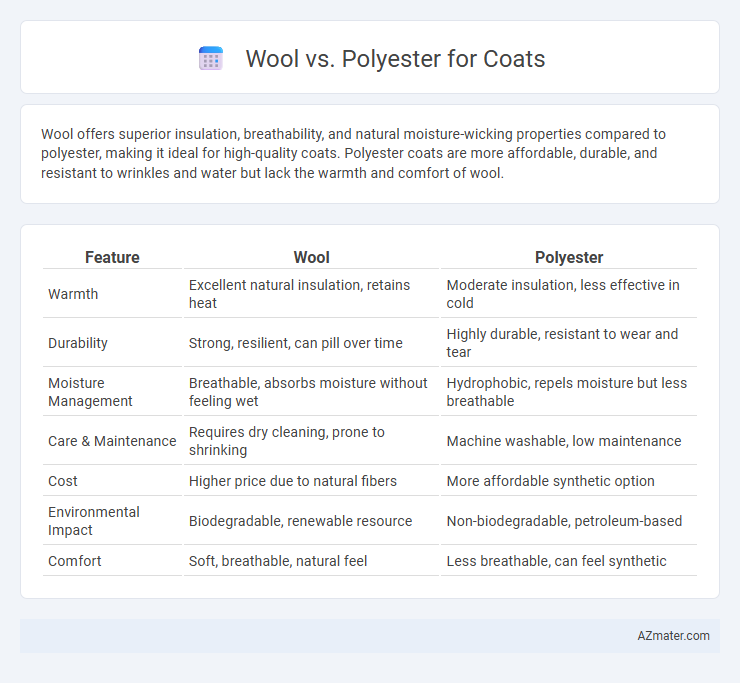Wool offers superior insulation, breathability, and natural moisture-wicking properties compared to polyester, making it ideal for high-quality coats. Polyester coats are more affordable, durable, and resistant to wrinkles and water but lack the warmth and comfort of wool.
Table of Comparison
| Feature | Wool | Polyester |
|---|---|---|
| Warmth | Excellent natural insulation, retains heat | Moderate insulation, less effective in cold |
| Durability | Strong, resilient, can pill over time | Highly durable, resistant to wear and tear |
| Moisture Management | Breathable, absorbs moisture without feeling wet | Hydrophobic, repels moisture but less breathable |
| Care & Maintenance | Requires dry cleaning, prone to shrinking | Machine washable, low maintenance |
| Cost | Higher price due to natural fibers | More affordable synthetic option |
| Environmental Impact | Biodegradable, renewable resource | Non-biodegradable, petroleum-based |
| Comfort | Soft, breathable, natural feel | Less breathable, can feel synthetic |
Introduction to Wool and Polyester Coats
Wool coats offer natural insulation, breathability, and moisture-wicking properties, making them ideal for cold weather wear. Polyester coats provide durability, resistance to wrinkles and stains, and often come at a lower price point with easy maintenance. Understanding the unique benefits of wool and polyester fabrics helps consumers choose coats that best fit their style, climate, and care preferences.
Comparing Warmth and Insulation
Wool offers superior warmth and insulation due to its natural crimped fibers that trap air effectively, providing excellent thermal regulation even in damp conditions. Polyester, a synthetic fiber, often lacks breathability and can retain moisture, resulting in less efficient insulation compared to wool. While polyester coats may offer lightweight and water-resistant benefits, wool remains the preferred choice for optimal warmth during cold weather.
Breathability and Comfort
Wool coats excel in breathability, allowing moisture to escape while maintaining warmth, making them ideal for regulating body temperature in varying climates. Polyester coats offer less breathability due to their synthetic fibers, which can trap heat and moisture, potentially causing discomfort during extended wear. Comfort in wool is enhanced by its natural fibers that adapt to body heat and provide softness, whereas polyester may feel less natural and cause sweating due to its less porous structure.
Durability and Longevity
Wool coats offer superior durability due to their natural fibers, which resist wear and tear while maintaining shape over time. Polyester coats provide excellent resistance to stretching and shrinking, with increased resistance to wrinkles and abrasions, contributing to long-lasting wear. Wool's inherent breathability and moisture-wicking properties enhance longevity by reducing odor and fabric breakdown compared to synthetic polyester.
Water Resistance and Weather Protection
Wool naturally repels water due to its lanolin content, providing excellent insulation and breathability while maintaining warmth in wet conditions. Polyester coats offer superior water resistance and quick drying properties, making them ideal for heavy rain and snowy weather. Both materials provide effective weather protection, but wool excels in temperature regulation, whereas polyester is favored for enhanced moisture durability.
Style and Aesthetic Appeal
Wool coats offer a timeless, luxurious texture that enhances sophistication and elegance, making them ideal for formal occasions and classic styles. Polyester coats provide a sleek, modern finish with vibrant color retention and versatility, suitable for contemporary and casual looks. Choosing between wool and polyester depends on desired aesthetic appeal, with wool emphasizing traditional refinement and polyester highlighting innovative design.
Maintenance and Care Requirements
Wool coats require delicate care, including dry cleaning to maintain fiber integrity and prevent shrinkage, while Polyester coats are machine washable and more resistant to wrinkles and stains. Wool's natural fibers absorb moisture and can develop moth damage without proper storage, necessitating moth repellents and regular airing. Polyester's synthetic composition ensures low maintenance, making it ideal for those seeking durability and ease of cleaning in outerwear.
Eco-Friendliness and Sustainability
Wool is a natural, biodegradable fiber that offers high sustainability due to its renewable sourcing from sheep and minimal processing requirements. Polyester, derived from petroleum, is non-biodegradable and contributes significantly to microplastic pollution and high carbon emissions throughout its production. Choosing wool over polyester for coats reduces environmental impact by supporting renewable materials and lowering synthetic waste in landfills and ecosystems.
Price Comparison: Wool vs Polyester
Wool coats typically cost significantly more than polyester ones due to the natural fiber's higher production and material expenses, with wool prices averaging $100 to $500 compared to polyester's $30 to $150 range. The durability and insulation properties of wool contribute to its premium price, while polyester offers a budget-friendly alternative with lower manufacturing costs. Consumers seeking affordable options often prefer polyester, whereas those prioritizing quality and warmth invest in wool despite the higher price tag.
Choosing the Best Fabric for Your Coat
Wool offers superior insulation, breathability, and natural moisture-wicking properties, making it ideal for warmth and comfort in cold weather coats. Polyester is more durable, water-resistant, and typically more affordable, providing easy care and resistance to wrinkles and shrinking. Choosing the best fabric depends on whether you prioritize natural warmth and softness (wool) or enhanced durability and low maintenance (polyester) in your coat.

Infographic: Wool vs Polyester for Coat
 azmater.com
azmater.com